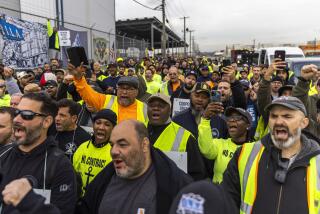Commuters Adrift as Strike Idles Long Island Rail Road : Labor: Talks collapse, and walkout may worsen New York congestion at a busy time. Gov. Cuomo urges federal action to force return of workers.
- Share via
NEW YORK — Motormen and conductors on Friday struck the Long Island Rail Road, the nation’s busiest commuter line, forcing more than 103,000 weekday riders to scramble to find ways to reach work and idling 725 trains along 701 miles of track.
Coming at the beginning of a weekend, many people simply elected to stay home. But officials feared that if the strike continued into next week, major traffic jams and hardships could occur.
Gov. Mario M. Cuomo asked President Clinton and Congress to quickly approve legislation forcing the strikers to return to their jobs during a 28-day cooling-off period and for binding arbitration.
The President urged both sides to resume “serious round-the-clock” bargaining, stating both the economic health of the region and the interest of passengers must be protected.
The strike comes at a busy time in New York. Thousands of gay men and lesbians began arriving in anticipation of Gay Games IV while 1.5 million New York Rangers fans, by police estimate, jammed lower Manhattan on Friday to cheer the Stanley Cup winners, who rode in a ticker-tape parade up Broadway to City Hall.
The celebration of the Rangers’ National Hockey League championship--the team’s first in 54 years--could presage another parade, many basketball fans hope. The New York Knicks and the Houston Rockets are locked in close combat in the National Basketball Assn. finals.
What normally would be a mere trip up an escalator to Madison Square Garden after a ride to Pennsylvania Station aboard the Long Island Rail Road was turned into a major struggle for thousands of suburban fans attending game five at the Garden on Friday night. Some left their cars in outlying areas and took the subway to the game. Others drove in and jammed nearby garages.
Negotiations between members of the United Transportation Union and management collapsed after about 14 hours of negotiations at the Huntington Hilton in Melville, Long Island.
Shortly before 1:30 a.m. EDT on Friday, Edward Yule Jr., the union’s general chairman, announced rejection of the railroad’s final offer of a pay increase of about 12.5% over four years. Union negotiators demanded 17% over 52 months.
“We’re not going to be stepped on by management,” Yule said.
Labor disputes are nothing new to the Long Island Rail Road, and based on their experience during the last strike, which lasted 11 days in January, 1987, some corporations and commuters made elaborate preparations.
Large banks and businesses like Citibank and Chemical Bank reserved blocks of hotel rooms in Manhattan--a scarce commodity given the preparations for the Gay Games and Cultural Festival, which holds opening ceremonies tonight. A massive march is scheduled a week from Sunday to commemorate the 25th anniversary of the Stonewall bar riot that helped launch the gay rights movement.
Some companies like McGraw-Hill hired its own fleet of buses for the trip from Long Island while many commuters drove to subway stations in Brooklyn and Queens and then took mass transit to Manhattan. Others formed car pools with neighbors and drove to work.
“We know we cannot replicate the service,” said Susan McGowan, a spokeswoman for the Long Island Rail Road. “We would need 13,000 buses or more to handle all of the passengers. But with the assistance of the New York City Transit Authority and other bus companies, we are providing some bus service that will connect to subways and hopefully handle some of the customers that way.”
During the last strike, railroad officials said 65% of their riders tried to make connections with the subway system. About 20,000 commuters drove to their jobs, creating in some cases traffic jams at tunnels and bridges. Still others simply decided to take vacations or to stay with relatives in Manhattan.
More to Read
Sign up for Essential California
The most important California stories and recommendations in your inbox every morning.
You may occasionally receive promotional content from the Los Angeles Times.













